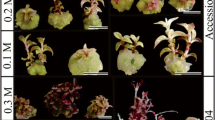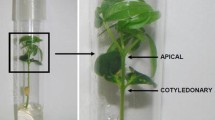Summary
Carbohydrate type and concentration and their interactive effects on in vitro shoot proliferation of three lingonberry (Vaccinium vitis-idaea ssp. vitis-idaea L.) cultivars (‘Regal’, ‘Splendor’, and ‘Erntedank’) and two V. vitis-idaea ssp. minus (Lodd) clones (‘NL1’ and ‘NL2’) were studied. Nodal explants were grown in vitro on medium with 2 μM zeatin and either glucose, sorbitol, or sucrose at a concentration of 0, 10, 20, or 30 gl−1. The interactive effects of carbohydrate type and concentration and genotype were important for shoot proliferation. The best response was afforded by sucrose at 20 gl−1 both in terms of explant response and shoot developing potential, although glucose supported shoot growth equally well, and in ‘NL1’ at 10 gl−1 it resulted in better in vitro growth than sucrose. Carbohydrate concentration had little effect on shoot vigor. The genotypes differed in terms of shoots per explant, length, and vigor, leaves per shoot, and callus formation at the base of explants; this was manifested with various types and concentrations of carbohydrate. Changing the positioning of explants on the medium from vertically upright to horizontal increased the shoot and callus size, but decreased shoot height and leaves per shoot. Proliferated shoots were rooted on a peat:perlite (1∶1, v/v) medium and the plantlets were acclimatized and eventually established in the greenhouse.
Similar content being viewed by others
References
Borkowska, B.; Szczerba, J. Influence of different carbon sources on invertase activity and growth of sour cherry (Pranus cerasus L.) shoot cultures. J. Exp. Bot. 42:911–915; 1991.
Chong, C.; Taper, C. D. Malus tissue cultures. I. Sorbitol (d-glucitol) as a carbon source for callus initiation and growth. Can. J. Bot. 50:1399–1404; 1972.
Coffin, R.; Taper, C. D.; Chong, C. Sorbitol and sucrose as carbon source for callus culture of some species of Rosaceae. Can. J. Bot. 54:547–551; 1976.
Compton, E. C. Statistical methods suitable for the analysis of plant tissue culture data. Plant Cell Tiss. Organ Cult. 37:217–242; 1994.
Debnath, S. C. Combined application of classical and biotechnological techniques in the development of small fruits important to Newfoundland and Labrador. Can. J. Plant Sci. 80:233; 2000.
Debnath, S. C. Micropropagation of small fruits. In: Jain, S. M.; Ishii, K., eds. Micropropagation of woody trees and fruits. Dordrecht: Kluwer Academic Publishers; 2003a:465–506.
Debnath, S. C. Improved shoot organogenesis from hypocotyl segments of lingonberry (Vaccinium vitis-idaea L.). In Vitro Cell. Dev. Biol. Plant 39:490–495; 2003b.
Debnath, S. C. In vitro culture of lowbush blueberry (Vaccinium angustifolium Ait.). Small Fruits Rev 3:393–408; 2004.
Debnath, S. C.; McRae, K. B. In vitro culture of lingonberry (Vaccinium vitisidaea L.): the influence of cytokinins and media types on propagation. Small Fruits Rev. 1:3–19; 2001a.
Debnath, S. C.; McRae, K. B. An efficient in vitro shoot propagation of cranberry (Vaccinium macrocarpon Ait.) by axillary bud proliferation. In Vitro Cell. Dev. Biol. Plant 37:243–249; 2001b.
Debnath, S. C.; McRae, K. B. An efficient adventitious shoot regeneration system on excised leaves of micropropagated lingonberry (Vaccinium vitis-idaea L.). J. Hort. Sci. Biotechnol. 77:744–752; 2002.
Dierking, W. Jr; Dierking, S. European Vaccinium species. Acta. Hort. 241:299–304; 1993.
Grizzle, J. E.; Starmer, C. F.; Koch, G. G. Analysis of categorical data by linear models. Biometrics 25:489–504; 1969.
Gustavsson, B. A.; Stanys, V. Field performance of ‘Sanna’ lingonberry derived by micropropagation vs. stem cuttings. HortScience 35:742–744; 2000.
Hulten, E. On the races in the Scandinavian flora. Svensk Botanisk Tidskrift Bd. 43:383–406; 1949.
Jaakola, L.; Tolvanen, A.; Laine, K.; Hohtola, A. Effect of N6-isopenteny-ladenine concentration on growth initiation in vitro and rooting of bilberry and lingonberry microshoots. Plant Cell Tiss. Organ Cult. 66:73–77; 2001.
Karhu, S. T. The quality of applied carbohydrates affects the axillary branching of apple microshoots. Bull. Rech. Agron. Gembloux 30:21–27; 1995.
Koch, G. G.; Amara, I. A.; Davis, G. W.; Gillings, D. B. A review of some statistical methods for covariance analysis of categorical data. Biometrics 38:563–595; 1982.
Kozai, T. Micropropagation under photoautotrophic conditions. In: Debergh, P. C.; Zimmerman, R. H., eds. Micropropagation—technology and application. Dordrecht: Kluwer Academic Publishers; 1991:447–469.
Lane, W. D. Regeneration of pear plants from shoot meristem tips. Plant Sci. Lett. 17:337–342; 1979.
Luby, J. J.; Ballington, J. R.; Draper, A. D.; Pliszka, K.; Austin, M. E. Blueberries and cranberries (Vaccinium). Acta Hort. 290:391–456; 1991.
Marcotrigiano, M.; McGlew, S. P. A two-stage micropropagation system for cranberries. J. Am. Soc. Hort. Sci. 116:911–916; 1991.
McClelland, M. T.; Smith, M. A. L. Vessel type, closure, and explant orientation influence in vitro performance of five woody species. HortScience 25:797–800; 1990.
Novelli, S. Developments in berry production and use. Bi-weekly Bull. Agric. Agri-Food Canada 16(21); 2003.
Pontis, H. G. On the scent of riddle of sucrose. TIBS 6: 137–139; 1978.
Prior, R. L.; Cao, G. Antioxidant phytochemicals in fruits and vegetables: diet and health implications. HortScience 35:588–592; 2000.
Serres, R. A.; Pan, S.; McCown, B. H.; Stang, E. J. Micropropagation of several lingonberry cultivars. Fruit Var. J. 48:7–14; 1994.
Smagula, J. M.; Harker, J. Cranberry micropropagation using a lowbush blueberry medium. Acta Hort. 446:343–347; 1997.
Stanek, E. J. III; Diehl, S. R.; Dgetluck, M.; Stockes, M. E.; Prokopy, R. J. Statistical methods for analyzing discrete responses of insects tested repeatedly. Environ. Entomol. 16:319–326; 1987.
Stark, R.; Hall, I. V.; Hendrickson, P. A. The partridgeberry of Newfoundland. Canadex. (Hort. Crops) 230; 1978.
Swedlund, B.; Locy, R. D. Sorbitol as the primary carbon source for the growth of embryogenic callus of maize. Plant Physiol. 103:1339–1346; 1993.
Thompson, M.R.; Thorpe, T. A. Metabolic and non-metabolic roles of carbohydrates. In: Bonga, J. M.; Durzan, D. J., eds. Cell and tissue culture in forestry, vol. 1. General principles and biotechnology. Dordrecht: Martinus Nijhoff Publishers; 1987:89–112.
Thorpe, T. A. Carbohydrate utilization and metabolism. In: Bonga, J. M.; Durzan, D. J., eds. Tissue culture in forestry. Dordrecht: Martinus Nijhoff Publishers; 1985:325–368.
Uno, S.; Preece, J. E. Micro- and cutting propagation of ‘Crimson Pygmy’ barberry. HortScience 22:488–491; 1987.
Vander Kloet, S. P. The genus Vaccinium in North America. Agric. Can. Publ. 1828; 1988.
Wang, H.; Cao, G.; Prior, R. L. Oxygen radical absorbing capacity of anthocyanins. J. Agric. Food Chem. 45:304–309; 1997.
Welander, M.; Welander, N. T.; Brackman, A. S. Regulation of in vitro shoot multiplication in Syringa, Alnus and Malus by different carbon sources. J. Hort. Sci. 64:361–366; 1989.
Author information
Authors and Affiliations
Corresponding author
Rights and permissions
About this article
Cite this article
Debnath, S.C. Effects of carbon source and concentration on development of lingonberry (Vaccinium vitis-idaea L.) shoots cultivated in vitro from nodal explants. In Vitro Cell.Dev.Biol.-Plant 41, 145–150 (2005). https://doi.org/10.1079/IVP2004590
Received:
Accepted:
Issue Date:
DOI: https://doi.org/10.1079/IVP2004590




